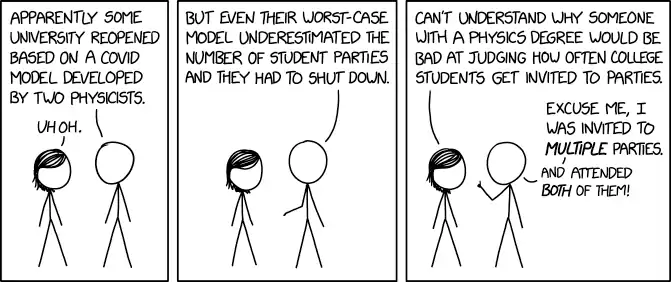2355: University COVID Model
|
| University COVID Model |
 Title text: I admit this is an exaggeration, since I can think of at least three parties I attended while doing my degree, and I'm probably forgetting several more. |
Explanation
This comic is another in a series of comics related to the 2020 pandemic of the coronavirus SARS-CoV-2, which causes COVID-19.
Cueball begins telling Megan an anecdote about how a college decided to reopen "based on a COVID model developed by two physicists." (The incident in question is likely a reference to this article and tweet about the University of Illinois, that went viral with similar wording the day before the comic was published). Presumably, the model predicted that the university could allow students to return to campus while still keeping cases of COVID-19 under control, perhaps using some combination of reduced classroom and residence hall density, and by implementing policies against large social gatherings.
Before he can get further, Megan interrupts him with "Uh oh," perhaps worried that an epidemiological model created by people who aren't epidemiologists could be ineffective (much like how stock-trading bots created by engineers were too good at making money on high-frequency stock markets, causing a flash-crash). Alternately, she may be expressing concern specifically about physicists' epidemiological modelling. Cueball then confirms her fears by saying that the model underestimated how many parties the students would hold, and so the actual number of cases on campus has turned out to be greater than even their worst-case prediction. Megan facetiously wonders how a physicist could have failed to know how much college kids party, implying that physicists do not attend many parties. Cueball, representing Randall, a physics major, then retorts that he "was invited to multiple parties! And attended both of them!" implying first that he was invited to many parties over an undefined period of time at college, but then admitting it was only two.
In the title text, Cueball (or perhaps Randall, no longer in-character) admits to attending at least a third party, and possibly a few more that have been forgotten, and confirms this was over the entire course of his degree studies, likely 4-8 years or more. This demonstrates, as an introverted physics major who struggles with social interactions, he (and by implied extension most Physics majors) has little interest in attending parties. As many other people go to college for the parties rather than the education[citation needed], we can only imagine how severely his campus epidemiology model would underestimate the number of opportunities for the coronavirus to spread.
A nontrivial number of colleges followed this trajectory in 2020, such as the aforementioned University of Illinois at Urbana-Champaign.
A different comic with physicists modeling another field is 793: Physicists.
Transcript
- [Cueball and Megan are talking to each other.]
- Cueball: Apparently some university reopened based on a COVID model developed by two physicists.
- Megan: Uh oh.
- [Cueball raises an arm slightly.]
- Cueball: But even their worst-case model underestimated the number of student parties and they had to shut down.
- [Cueball holds up a finger.]
- Megan: Can't understand why someone with a physics degree would be bad at judging how often college students get invited to parties.
- Cueball: Excuse me, I was invited to multiple parties.
- Cueball: And attended both of them!
![]()
![]()
![]()
Discussion
Wait, people in college go to parties? Hm. Must be something people sent to High School for "socialization", participate in. ProphetZarquon (talk) 21:04, 4 September 2020 (UTC)
I went to high school and didn't party once at college. So...I guess not? 23:06, 4 September 2020 (UTC)
- I don't remember any college party, but I must admit I might missed it while playing FPSs in computer laboratory. Or does that count as party? It is group activity, but there is usually no alcohol involved and social distance is preserved ... -- Hkmaly (talk) 02:34, 5 September 2020 (UTC)
- Well, some college students go to a lot of parites, but others don't. It's probably a lot less common among students who spend a lot of time on computers or who have majors in more difficult and mathematically rigorous scientific fields, and more common in certain other majors, people who are in frats, and those who are mainly in college to be on a sports team.--162.158.74.61 05:36, 5 September 2020 (UTC)
This likely relates to https://xkcd.com/793/, do we want to mention that? 172.69.42.44 21:47, 4 September 2020 (UTC)
- That would be great. Do you know where to put it? I was surprised the linked article said it was students who tested positive from the school's tests who actually hosted the parties. Interesting cultural share between the two kinds of personalities. 162.158.62.105 01:06, 5 September 2020 (UTC)
"...and they had to shut down." Unrealistic, real universities send their president to join the party, 0/10. 108.162.216.142 20:53, 6 September 2020 (UTC)
"stock-trading bots created by engineers were too good at making money on high-frequency stock markets, causing a flash-crash" The flash crash was caused by what I would describe as a computer bug (the theory is that multiple stock trading bots made by different people entered a loop where they would buy and sell the same shares from each other at increasing prices). If the stock trading bots were really "too good" then they wouldn't have this issue. Also, there were a good deal of finacially-trained bankers behind the creation of high frequency trading systems, with the actual "engineers" often not really understanding how the systems worked. The linked comic has nothing to do with high frequency trading. Probably not Douglas Hofstadter (talk) 17:42, 7 September 2020 (UTC)